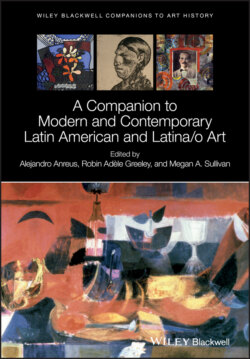Читать книгу A Companion to Modern and Contemporary Latin American and Latina/o Art - Группа авторов - Страница 62
7.2 Mexican But Universal
ОглавлениеOf Paz's 1950 campaign of cosmopolitan mythologization, there remains only a trace – the notion, incessantly repeated, that Tamayo is the incarnation of the “universal Mexican.” Paz's reasoning, in this regard, is a teleology of Mexican culture: “the Revolution is a return to origins as well as a search for a universal tradition.” In this argument, Tamayo appears as the resolution to a conflict – the absence of a truly universalist philosophy in the Mexican Revolution. Today we would say that Paz belonged to a state without a project of global power. Given this marginalization, what alternatives were open to an eminently centripetal culture?
This is where it is worth examining the oxymoron of the “universal‐Mexican,” because this formula admirably summarizes several of the paradoxes of the peripheral imaginary in modernity. To begin with, this categorization sees “universality” as a principal of exception; it identifies it as a rank that can be reached only by those artists who are saved from the sin of particularity. Becoming “internationalized” means being (or attempting to be) recognized in the metropolises as a participant in the history of art. This category is of course made for local consumption, because it is back in the homeland where (contradictorily) this internationalism becomes effective.
In any case, if this national/international artistic system differs in any way from our own emerging global system, it is in how it depicts itself as a progression of exclusions, where everything is “national,” “regional” or “municipal” until it is locally believed that such and such an artist takes part in the metropolitan game. This contrasts with the global circuit, where the center embraces the game of minorities and old colonies, in order to keep on appearing metropolitan.
The fact is that, despite all of these neocolonial features, the concept of the “national‐universal” continues fundamentally to drive the unconscious of Latin American criticism and cultural administration. And a mediator – “universal‐Mexican” (Tamayo, Paz) or “universal‐Argentinian” (Borges) – is always established to prevent the local from drowning in its provincial inertia. The concept encapsulates the failure of the peripheries to obtain an effective place in the symbolic distribution of high modernism. This is how criticism devolves into history: as an unpaid balance submerged in ideology.
Of course, this negotiation between the local and the universal is complicated. One of its paradoxes is that it attributes a supposed universality precisely to a local practice that embraces autochthonous features only when they are sublimated. As Olivier Debroise has demonstrated, elevating Tamayo to the rank of “universality” provoked instability in his racial identification, which shifted progressively from the myth of his Indian origin to his proclamation in a 1987 interview that “I am mestizo. I am Mexican, because the true Mexican is mestizo” (Debroise 2004, p. 130). Indeed, it was in 1948 that another poet, Xavier Villaurrutia, first called Tamayo “this universal Mexican painter” – one who knew how to take the tropics to painting “like an inner sun,” devoid of folkloric traces, as a “inalienable legacy of his ancestors both recent and remote” (1966, p. 1036–1040) There is, moreover, an extravagant and ominous line in this essay that describes better than any other the implicit meaning of this universalization: “Time,” wrote Villaurrutia, “has lightened the color of Rufino Tamayo's skin” (1966, p. 1034).
